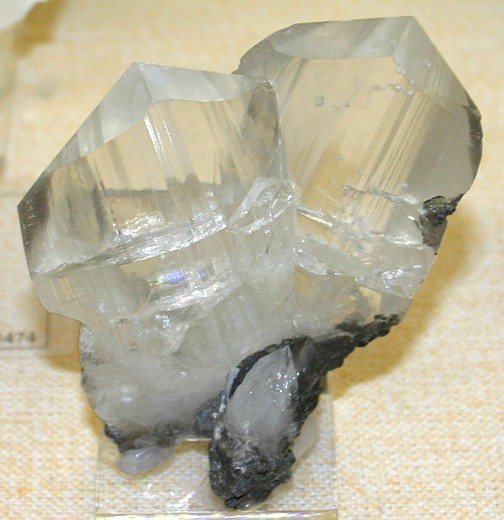|
.
Angelesite
Mineral Facts:
Chemical Formula: Pb(SO4)
Lead sulfate,
PbS04; lead oxide 73.6%
Colors:
Colorless, white, pale
shades of yellow, green and blue. May be colored dark gray, etc., by
impurities.
Hardness:
2.5 to 3
Density:
6.3 to 6.4
Cleavage:
Perfect cleavage
parallel to base and prism on P(001) and P(110).
Crystallography:
Orthorhombic.
Crystals are usually
prismatic or isometric in habit. Tabular habits are less common
than in barite and
celestite.
Luster:.
Usually adamantine,
sometimes inclining to resinous or vitreous; transparent to opaque.
Optics: (Refractive Index) =
a = 1.877; y
= 1.894
|
 |
|
Composition, Structure and
Associated Minerals:
Anglesite is a
common lead mineral of secondary origin. It is formed through the oxidation
of galena, sometimes directly to the sulphate as is shown by the concentric
layers of anglesite found at times surrounding a core of unaltered galena,
or sometimes by an intermediate solution and subsequent recrystallization.
Found in the upper, oxidized portions of lead veins, associated with galena,
cerussite, sphalerite, smithsonite, calamine, iron oxides, etc. It is found
mainly in the upper portions of veins of lead ores. Under the influence of
solutions of carbonates it changes to cerussite.
Identification
and Diagnostics
The mineral is characterized by its
high specific gravity and the reaction for lead. It is distinguished from
cerussite by the reaction for sulfur and the lack of effervescence with
HC1.It is also recognized by its adamantine luster and frequently by its
association with galena. Easily fusible at 2.5. On
charcoal with sodium
carbonate reduced to a lead globule with yellow to white coating of lead
oxide. Fused with sodium carbonate and charcoal dust gives a residue, which,
when moistened, produces on a clean silver surface a dark stain of silver
sulphide (test for sulfur).
Occurrence,
Localities and Origins:
Anglesite, when
found in sufficient quantity, is a valuable lead ore. It is usually
associated with galena, and results from the decomposition of that mineral
in the upper portion of lead veins. In the United States, it occurs as
crystals at Phoenixville, Pennsylvania; in the lead districts of the
Mississippi Valley, Carroll County, Maryland; at various points in Colorado
and the Rocky Mountains; at Cerro Gordo, California
Notable world wide localities are Monte Poni, Sardinia;
Derbyshire and Cumberland, in England; Island of Anglesea, England; at
Leadhills, Scotland; various localities in Hungary, near Siegen, in Prussia;
etc. Found in large amounts in Australia at Lead Hills and Broken Hill (N.S.W.),
and in the Sierra Mojada, in Mexico.
.Return
to the
Mineral Collectors Information Page |
|


